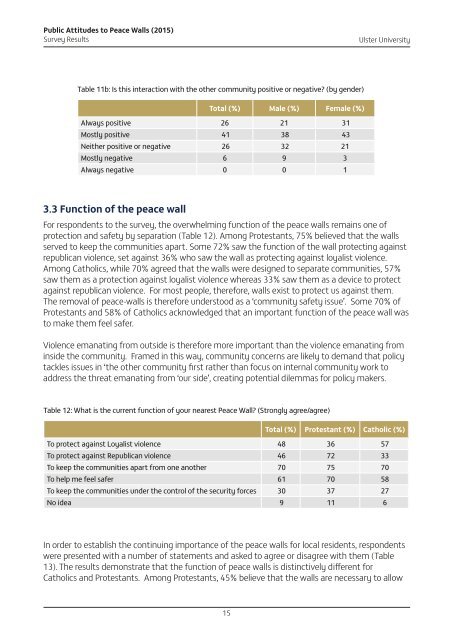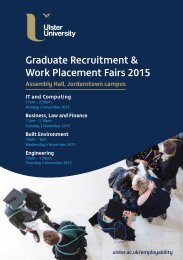Public Attitudes to Peace Walls (2015)
1RRkqqy
1RRkqqy
You also want an ePaper? Increase the reach of your titles
YUMPU automatically turns print PDFs into web optimized ePapers that Google loves.
<strong>Public</strong> <strong>Attitudes</strong> <strong>to</strong> <strong>Peace</strong> <strong>Walls</strong> (<strong>2015</strong>)<br />
Survey Results<br />
Ulster University<br />
Table 11b: Is this interaction with the other community positive or negative? (by gender)<br />
Total (%) Male (%) Female (%)<br />
Always positive 26 21 31<br />
Mostly positive 41 38 43<br />
Neither positive or negative 26 32 21<br />
Mostly negative 6 9 3<br />
Always negative 0 0 1<br />
3.3 Function of the peace wall<br />
For respondents <strong>to</strong> the survey, the overwhelming function of the peace walls remains one of<br />
protection and safety by separation (Table 12). Among Protestants, 75% believed that the walls<br />
served <strong>to</strong> keep the communities apart. Some 72% saw the function of the wall protecting against<br />
republican violence, set against 36% who saw the wall as protecting against loyalist violence.<br />
Among Catholics, while 70% agreed that the walls were designed <strong>to</strong> separate communities, 57%<br />
saw them as a protection against loyalist violence whereas 33% saw them as a device <strong>to</strong> protect<br />
against republican violence. For most people, therefore, walls exist <strong>to</strong> protect us against them.<br />
The removal of peace-walls is therefore unders<strong>to</strong>od as a ‘community safety issue’. Some 70% of<br />
Protestants and 58% of Catholics acknowledged that an important function of the peace wall was<br />
<strong>to</strong> make them feel safer.<br />
Violence emanating from outside is therefore more important than the violence emanating from<br />
inside the community. Framed in this way, community concerns are likely <strong>to</strong> demand that policy<br />
tackles issues in ‘the other community first rather than focus on internal community work <strong>to</strong><br />
address the threat emanating from ‘our side’, creating potential dilemmas for policy makers.<br />
Table 12: What is the current function of your nearest <strong>Peace</strong> Wall? (Strongly agree/agree)<br />
Total (%) Protestant (%) Catholic (%)<br />
To protect against Loyalist violence 48 36 57<br />
To protect against Republican violence 46 72 33<br />
To keep the communities apart from one another 70 75 70<br />
To help me feel safer 61 70 58<br />
To keep the communities under the control of the security forces 30 37 27<br />
No idea 9 11 6<br />
In order <strong>to</strong> establish the continuing importance of the peace walls for local residents, respondents<br />
were presented with a number of statements and asked <strong>to</strong> agree or disagree with them (Table<br />
13). The results demonstrate that the function of peace walls is distinctively different for<br />
Catholics and Protestants. Among Protestants, 45% believe that the walls are necessary <strong>to</strong> allow<br />
15




